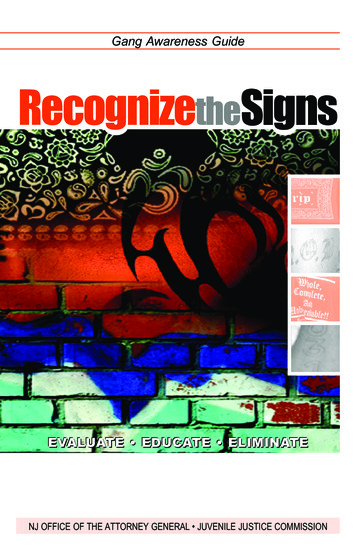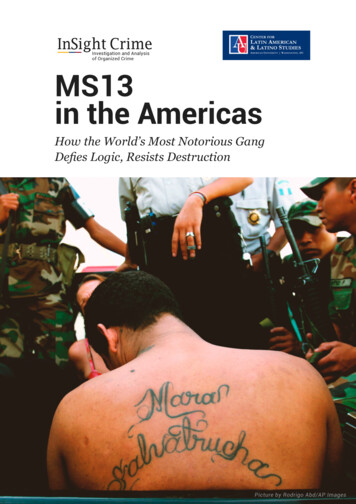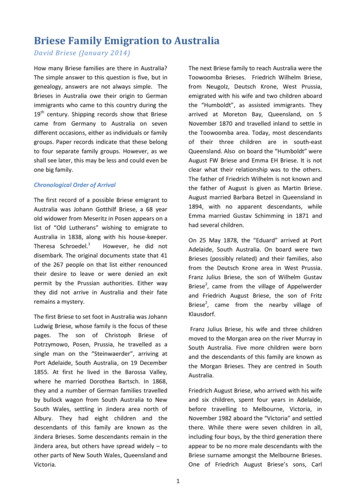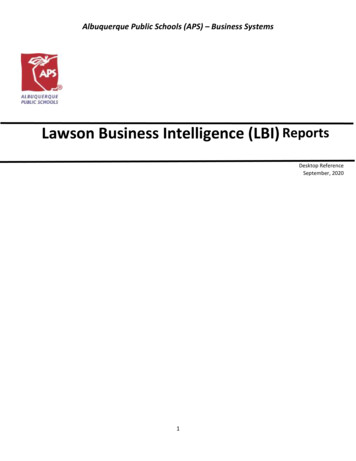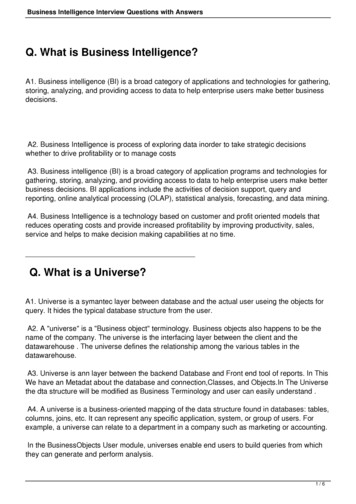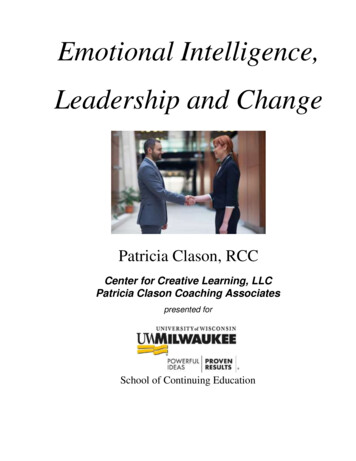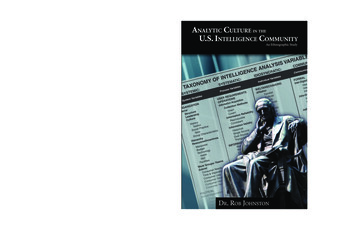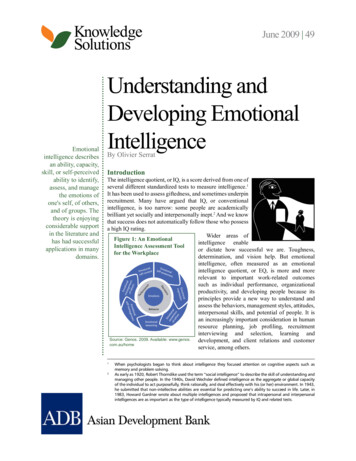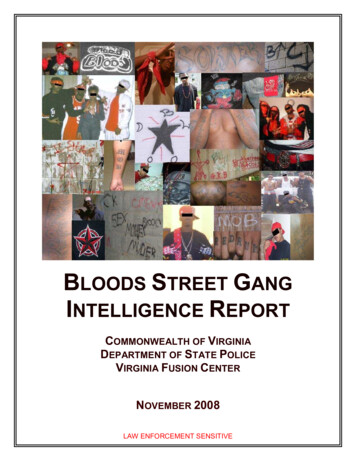
Transcription
BLOODS STREET GANGINTELLIGENCE REPORTCOMMONWEALTH OF VIRGINIADEPARTMENT OF STATE POLICEVIRGINIA FUSION CENTERNOVEMBER 2008LAW ENFORCEMENT SENSITIVE
BLOODSINTELLIGENCE REPORTThis is LAW ENFORCEMENT SENSITIVE information and is protected by Code of Virginia Title 52-48and 52-49 unless otherwise noted. Further distribution of this document is restricted to law enforcementagencies, intelligence agencies, and Department of Defense organizations only. Prior approval shall beobtained from VFC for dissemination to other agencies. Persons or organizations violating distributionrestrictions may be prosecuted and will be prohibited from receiving future documents. NO REPORT ORSEGMENT THEREOF MAY BE RELEASED TO ANY MEDIA SOURCES. Please contact the VirginiaFusion Center at (804) 674-2196 if you have any questions or need additional information.TABLE OF CONTENTSOVERVIEW .3HISTORY .3West Coast . 4Chicago Influence . 4East Coast. 5GANG ORGANIZATION AND STRUCTURE .7SYMBOLS AND IDENTIFICATION .8Colors:. 8Tattoos: . 9Gang Graffiti: . 9Hand Signs: . 10Codes and Language:. 11RIVALS .11RECRUITMENT & INITIATION .12THREATS TO LAW ENFORCEMENT .13WEB PRESENCE .14EXTREMIST LINKS .15VIRGINIA PRESENCE .17CONCLUSION .18RECOMMENDATIONS .19SOURCES OF INFORMATION .21APPENDIX A .23APPENDIX B.27LAW ENFORCEMENT SENSITIVE2
BLOODSINTELLIGENCE REPORTOVERVIEWThe Bloods street gang has become one of the most violent andnotorious criminal organizations, spreading its influence in the U.S.from coast to coast. A traditionally African American gang, Bloodsmembership today includes Caucasians, Hispanics, and Asians.Blood members are involved in a variety of criminal activitiesincluding murder, assault, robbery, and narcotics distribution.Nationally, gang membership in the Bloods has been estimatedbetween 15,000 and 20,000 members.1 Blood sets range fromhighly organized and structured groups similar to the Italian Mafia toloosely organized cliques with little discipline and loyalty. TheBloods have grown in popularity over the years thanks in part to the proliferation ofmusic, movies, and television shows glorifying the “gangsta” lifestyle as well as socialnetworking sites and the vast amount of information on the gang available on theInternet. Current intelligence gathered by the Virginia Fusion Center and other lawenforcement agencies indicates the Bloods are a significant criminal threat to theCommonwealth and will continue to grow in numbers and operational scope.HISTORYThe Bloods gang sets today are influenced by theorganizations founded in Los Angeles, New YorkCity, and Chicago. The Bloods were originally aWest Coast gang; however, their rise to power onthe East has undoubtedly surpassed their presenceon the West, and Blood sets commonly describethemselves as being affiliated to the East or WestCoast. The Bloods are part of the People Nation, astreet gang alliance that includes the Latin Kings,Vice Lord Nation, and the Black P-Stone Nation.Although the Bloods may appear to be a largeumbrella organization, each set has different rules,codes, alliances, and rivals. Therefore, what is truefor one set may not be true for another.Understanding the gang set’s culture and symbology may indicate a great deal aboutthe group’s structure, history, and operational scope.1National Drug Intelligence Center: Gang Profile - Bloods, February 2003LAW ENFORCEMENT SENSITIVE3
BLOODSINTELLIGENCE REPORTWest CoastThe Bloods began in the early 1970s in Los Angeles, CA, for protection against a largermore domineering gang, the Crips. The Crips had formedfollowing the dismantling of the Black Panther Party and hadquickly grown in numbers by absorbing local street gangs.Several local gangs refusing to join the Crips or submit totheir takeover of their neighborhood formed an anti-Cripalliance. The local sets of anti-Crips included the Piru StreetBoys, the LA Brims, the Denver Lanes, the InglewoodFamily, the Swans, and the Pueblo Bishops.2 The membersof these anti-Crip alliance groups began calling each other“Blood” leading to the united sets becoming known as theBloods. By the end of the 1970s, the Bloods had significantlyincreased their numbers and expanded their territory;however, they were still outnumbered by the Crips sets by a3margin of three to one. This underdog status contributed to the Bloods making areputation for being one of the most violent and ruthless street gangs. The Crips stilloutnumber the Bloods on the west coast, but the Bloods have maintained their notorietyas a significant criminal organization. During the 1980s, the Bloods became heavilyinvolved in the distribution of crack cocaine. Their successes in narcotics distributionled to the Bloods expansion eastward.Chicago InfluenceIn Chicago, Illinois, during the 1980s, two large coalitions of gang affiliates were createdto protect those members within federal and state prisonsystems. The two alliance names that emerged were thePeople Nation4 and Folk Nation.5 All gangs that wereoriginally aligned with the Black P-Stone Nation fell underthe People Nation. Those that were originally aligned withthe Black Gangster Disciple Nation aligned with the FolkNation. Many gangs are aligned with one of the twoChicago nations, and the Bloods align with the PeopleNation.62MAGLOCLEN, Bloods Intelligence Report, July 2007National Drug Intelligence Center: Gang Profile - Bloods, February 20034People Nation Gangs: Bishops, Black Peace Stones, Bloods, Cobra Stones, El Rukns, Future Stones, Gaylords,Insane Popes, Insane Unknown, Kents, King Cobras, Latin Counts, Latin Kings, Latin Dragons, Latin Pachucos, LatinSaints, Spanish Lords, Vice Lord Nation5Folk Nation Gangs: Black Gangster Disciples, Black Disciples, Cobras, Crips, Gangster Disciples, La Raza, Eagles,Latin Disciples, Maniac Latin Disciples, Simon City Royals, Spanish Gangsters, Two Sixers6Chicago Gangs: People & Folk History, accessed September 24, 20083LAW ENFORCEMENT SENSITIVE4
BLOODSINTELLIGENCE REPORTBlood sets today that are aligned with or influenced by the People Nation will usesymbology and cultural references tied to the People Nation. These symbols includethe number five, a five-pointed star, and a five-pointedcrown. Those gangs aligned with the Folk Nation,including the Crips, will use the number six, a sixpointed star, and a six-pointed crown.7 Rival gangs willoften invert or cross out each other’s symbols as a signof disrespect. For instance, Blood members may drawan upside-down pitchfork or draw a line through thenumber six when writing graffiti as an insult to theirrivals. Not all Blood sets are aligned with the PeopleNation, but many of them use the symbols, particularlythe number five in their graffiti, tattoos, and clothing.East CoastBy the early 1990s the Bloods presence had spread across the country, but it was notuntil two inmates at Riker’s Island correctional facility in New York joined together thatthe gang gained popularity in the East. During this time period, the Latin Kings andNetas gangs dominated the prison system, harassing and intimidating the AfricanAmerican inmates. In 1993, Omar “OG Mack” Portee along with Leonard “Deadeye”McKenzie formed the United Blood Nation (UBN) as a way to protect themselves fromthe Hispanic gangs. Portee and McKenzie adopted the Blood moniker, which by thattime had become a household name. Portee and McKenzie were also influenced by theBlack Panther Party and adopted a gang philosophy that capitalized on the perceptionof oppression of minorities.8 The duo wished to foster unity among the AfricanAmerican inmates and with their new gang, began targeting Hispanic gang members.Although UBN was started in the same defensive spirit as the original West CoastBloods, the new East Coast Bloods had not received a blessing from the West, andUBN was not considered a sanctioned Blood set. To this day, West Coast Bloods donot recognize the UBN as “real” Bloods.78Gangs or Us: Folk and People Nations, accessed October 1, 2008National Drug Intelligence Center: Gang Profile: United Blood Nation, September 2003LAW ENFORCEMENT SENSITIVE5
BLOODSINTELLIGENCE REPORTDespite their unofficial status, the United Blood Nation prospered inthe prison systems and was later transplanted to the streets. TheUBN perpetrated a reputation of being extremely violent due to theirinitiation practice known as a “Buck 50.” Potential members wouldcut non-gang members’ faces to the extent they would need 150stitches. Attacking non-gang members, or neutrals, went againsttypical West Coast Blood practices, which preferred to target rivalgangs. Sets united under the UBN included Nine Trey Gangsters(NTG), 1-8-3, Sex Money Murder (SMM), and Gangster Killer Bloods(GKB). In its initial conception, the UBN sets had distinctive roles; forinstance the NTG set were the enforcers, 1-8-3 were the “teachersand breeders,” and SMM were the money handlers.9 While some sets today maintaintheir historic role in the UBN, other sets have not maintained this regimentedorganization.In the mid to late 1990s, the United Blood Nationbecame a dominant gang on the East Coast,outnumbering the Crips. Their meteoric rise to the topof the gang hierarchy was halted in 2001 whenfounder Portee was arrested and later convicted offederalRacketeerInfluencedandCorruptOrganization (RICO) charges. Portee was sentencedto 50 years and is currently incarcerated in the federalsuper-max prison in Colorado.10 In the years sincePortee’s incarceration, the UBN has splintered.McKenzie, co-founder and once-prominent member,has allegedly retired from the gangster lifestyle. Other prominent UBN members haveeither been killed or imprisoned, creating a power vacuum. UBN sets have turnedagainst each other making the East Coast Bloods more dangerous than ever.Not all East Coast Bloods have ties to the United Blood Nation; however, the UBN getsmost of the credit for establishing the gang’s foothold in the East. Sets such as the NewJersey based Double II’s have West Coast ties and sets like these are recognized bythe West Coast Bloods. The various Bloods sets present in Virginia display either aWest, East, and/or Chicago influence; some sets appear to be an amalgamation of thedifferent influences.9History Channel: Gangland: Blood Oath DVD, 2008LA Times: 50 Years for Founder of East Coast Most Violent Gang, April 15, 200310LAW ENFORCEMENT SENSITIVE6
BLOODSINTELLIGENCE REPORTGANG ORGANIZATION AND STRUCTUREHierarchy within the gang structure may take several different forms depending on thegang’s affiliation to the West or East Coast. Sets have been known to adopt aparamilitary structure as well as a mafia inspired hierarchy. Below are two examples ofhierarchy used.11Southside Brim:121. Triple OG2. OG3. Baby OG4. OYG5. Young Gangster6. OBG7. Baby GangsterNine Trey Gangsters:131. Godfather2. Big 0203. Low 0204. 5 Star General5. 4 Star General6. 3 Star General7. 2 Star General8. 1 Star GeneralGang sets may use additional organizational structures including ranks of ministers,captains, and lieutenants. The head of the set is typically known as an OriginalGangster (OG) or Godfather. The set leader may be in contact with other set leadersbut the lower level soldiers may have no knowledge of other sets, their activities, or theirleadership.Blood sets that share set names with the larger West Coast14 and East Coast Bloods15may not be directly connected to the larger gangs but usually have knowledge of thegang’s history and rules. Many Blood gangs operate as independent sets although11Each set may have a different hierarchy and some unorganized sets may have little to no defined leadership.When encountering a new gang set, it should not be assumed they follow previously established hierarchy practices.12Petersburg Police Department: Confiscated Gang Documents, April 200813Carrboro, North Carolina Police Department: Confiscated Blood Bible, April 2008 (According to the confiscateddocuments, additional sets using this hierarchy include Gangster Killer Bloods, G-Shine, Mad Dog, and ValentineBloods)14Typical West Coast affiliated sets include the terms Piru or Brim in their name15East Coast sets include Nine Trey Gangsters, Gangster Killer Bloods, G-Shine, Valentine Bloods, and Sex MoneyMurderLAW ENFORCEMENT SENSITIVE7
BLOODSINTELLIGENCE REPORTmembers may know or be related to Bloods in other areas. Additionally, sets may beconnected through inmates in the prison system. Many small local gangs’ ties to thelarger Bloods sets may be tenuous at best. These smaller sets may mimic the cultureof the Bloods in terms of colors, clothing, and tattoos; however, their membership andscope of criminal activity is primarily local.SYMBOLS AND IDENTIFICATIONThe Bloods, like many street gangs, have created a unique form of identificationincluding language, apparel, tattoos, graffiti, and hand signs. The gang has created anentire subculture with variations from coast to coast and set to set.Colors:Traditional Blood colors are red and black, but sets have been known to utilize green,brown, pink, beige, and orange as well.16 The colors a setchooses are determined by their influences, alliances, andpreferences; however, a trend has also been noted wheregangs are choosing to refrain from wearing their traditionalred to deflect attention from law enforcement. Colors areworn as a sign of pride in their gang affiliation as well asan intimidation factor to non-gang members and rivals. Gang members will representtheir set by “flagging,” or wearing bandanas. These bandanas or “flags” can be wornaround the head, face, wrist, ankles, or in their back pocket.17 Having a flag is verysignificant to a gang member; typically flags are given at the time of initiation into thegang. It is considered disrespectful to let a flag fall on the ground and rival gangmembers will make a show of throwing their rival’s flag on the ground and stepping on itto show disrespect.Beyond wearing flags to show their gang affiliation, Blood members oftenwear clothing, jewelry, and other accessories tied to their gang torepresent their set. Any type of apparel in their traditional color of red canbe exploited by gang members including clothing with cartoon charactersand sports paraphernalia. Gang members may also wear handmadebead necklaces and modified rosaries in their gang colors.16Washington Regional Threat and Analysis Center, Intelligence Bulletin 2008-26: Bloods Gang, January 31, 2008There have been numerous reports on the Bloods and other street gangs indicating the position of the flag on thebody has special meaning. For instance, a flag tied around the head may indicate the member is selling drugs; a flagtied around the belt loop means a member is carrying a weapon. The meaning behind the placement of the flag isnot universal among gang members. Caution should be used in dealing with all suspected gang members regardlessof flag placement.17LAW ENFORCEMENT SENSITIVE8
BLOODSINTELLIGENCE REPORTTattoos:Many gang members will have at least one gang related tattooor branding. The photo to the left represents a “dog paw” andis typically made using the heated barrel of a handgun. Thedog paws are very common on Bloods members and are oftenburned into the right shoulder or upper arm area.18 Gangmembers may refer to the dog paws as “triple Os” and themarks may be present in graffiti as well. Conventional Bloodtattoos may include the word “blood,” the set name, fivepointed stars or crowns, the member’s street name, weapons,tear/blood drops, and pit bulls.19 The tattoo’s craftsmanshipcan range from crude jail or homemade designs to intricateprofessional work. Tattoos and brands, particularly the dogpaws, may be given upon initiation into the gang, and they mayalso signify the rank of the member. When encounteringsuspected gang members, tattoos should be documented asthey can reveal a member’s set affiliation, rank, involvement in criminal activity, andyears of gang participation.Gang Graffiti:Graffiti has often been described as the “newspaper of thestreets.” Careful analysis of gang graffiti can indicate the gangand set, the artist or tagger, their affiliation, rival gangs, andcurrent gang activity. Gangs use graffiti to claim territory, andwhere there are several gangs present, graffiti may be markedout by rival gangs and replaced with their own. Gang membersmay also venture into their rival’s territory to deface propertywith graffiti as a sign of disrespect and a challenge to theirrival.20 Typical gang graffiti is usually in a single color and will be simple in design.Complex and colorful graffiti is generally not gang related.18Many Blood sets in Virginia “rep” to the right, meaning members wear their flags, have tattoos, and wear their hatsto the right side; however, depending on the set, members may also “rep” to the left.19MAGLOCLEN, Bloods Intelligence Report, July 200720Entropic Memes: Deciphering Gang Graffiti, accessed September 29, 2008LAW ENFORCEMENT SENSITIVE9
BLOODSINTELLIGENCE REPORTHand Signs:Gang hand signs are used by members to greet one another, give silentwarnings, and intimidate non gang members and rivals. Common Bloodsigns include the letter B (top right) and the letters C K for Crip Killer(bottom right). Additional hand signs include blood spelled out and thefive pointed star (middle right). Each set may also have its own uniquehand signs. Sets have been known to use signs similar to AmericanSign Language as well as developing their own complex and uniquesigns to represent words and phrases. The Bloods also use additionalnon-verbal communications to convey messages to other members inthe way they walk, stand, and gesture. Documents recovered by thePetersburg Police Department revealed a complex set of body languageused by a Blood set known as Southside Brim.21 Common gesturessuch as rubbing the ear, scratching the forehead, or wiping a shoe couldconvey to other members a multitude of hidden messages. Bloodsmembers use these signs for casual communication as well as a way tocommunicate violent intentions. The signs listed below are examples ofwhat one set has used and may not be common to all Blood sets.Body LanguageWipe FaceRub HeadScratch ForeheadBlinkRub NoseLeaning on a wall or other object with one legperched upRub EarRight Hand Massages Left ShoulderLeft finger inside right fist, twist then take outRub stomachLook at fistWipe Bottom of Shoe21MeaningIdentifies PoliceHit a target right thereFight is about to take placeDo you have a weapon?I don’t have a weaponI do have a weaponGo get your guns and come right backI’m about to rob somethingFight / Attack enemiesSurround enemy, get ready for attackBe carefulIdentifies an enemyPetersburg Police Department: Confiscated Gang Documents, April 2008LAW ENFORCEMENT SENSITIVE10
BLOODSINTELLIGENCE REPORTCodes and Language:The Bloods’ use of coded language was originally designed to prevent correctionalofficers from understanding inmates’ communication,either verbal or written. The codes have been taken tothe streets to disguise what gang members say frompolice. Depending on the Blood set, the gang membersmay use a variety of numbers, codes, and slang tocommunicate with each other. Although codes vary,commonalities in greetings, warnings, and generalcommunication exist. A common greeting among Bloodsmembers is “SuWoop!” (representing a police siren) andmembers will often say “Blaat!” (representing the sound of automatic gunfire) toannounce their presence. The numbers 0, 3, and 1 are very significant to East Coastaffiliated Bloods and will appear in their graffiti and tattoos. Zero represents Bloods,three stands for the 31 rules they have to follow, and one represents the love for allBloods under one umbrella.22 Based on these numbers, October 31 has beendesignated as the “birthday” of the East Coast Bloods and the UBN.23 Additionally,rumors circulate every year around this date of attacks by Bloods members against lawenforcement.Blood members have created acronyms for names and symbols they use, including“Blood” (Black Love Over Our Depression)24, “Red” (Respect Every Dawg), and theSwahili word for blood, “Damu” (Drama Against Men Unified).25 Coded language usedby the Bloods is often unique to the set and varies with location. Confiscateddocuments recovered by law enforcement reveal the extent to which the gang membersgo in order to disguise their communications. Codes, slang, and other special languageare routinely being modified, and law enforcement should pay careful attention for newtrends.RIVALSThe Bloods’ most notorious rivals are the Crips, and tensionsbetween the two gangs are present today in gang relatedattacks and graffiti (photo at left is a traditional Crip graffitidisplay where “BK” stands for Blood Killer). Bloods often referto the Crips as “Krabs” and Crips call the Bloods “Slobs.” Onthe West Coast, the Crips outnumber the Bloods, while the22Carrboro, North Carolina Police Department: Confiscated Blood Bible, April 2008Maryland State Police – Homeland Security & Intelligence Division: Bloods Birthday, October 17, 200624Additionally acronym translations for BLOOD(S) include Brotherly Love Overriding Oppression and Destruction ofSociety; Brotherly Love Overrise Our Demise; Bloods Love Only Our Dawgs (Virginia Department of Corrections:Slob Knowledge – Blood Gang Knowledge Written by a Crip, February 2008)25Petersburg Police Department: Confiscated Gang Documents, April 200823LAW ENFORCEMENT SENSITIVE11
BLOODSINTELLIGENCE REPORTopposite is true on the East Coast. The Crips will likely continue to be the target ofchoice for Bloods, but there is some evidence that certain sets have put aside theirdifferences and formed alliances. Several states have noted alliances between the twowhen it appears their cooperation will benefit each other financially. Certain sets of thetwo gangs have cooperated in narcotics sales, prostitution, money laundering, firearmsprocurement, and armed robbery. The cooperation can extend as far as creating a newgang which may adopt the color purple to show the blending of the red and blue.26 Alocal gang set known as Purple Haze is an example of such in Norfolk, Virginia.27Due to Blood sets’ often independent nature, theirrivals and alliances may be locally based. Additionalrivals have been noted but they are not alwaysuniversal among the Bloods. Mara Salvatrucha 13(MS13) has been identified as a Blood rival; however,other Hispanic gangs such as the Latin Kings haverecently been aligning with Blood sets.28The Blood gang is not immune from infighting between sets. In August 2007, a gangfeud developed between the Nine Trey Gangsters (NTG) and the Gangster Killer Bloods(GKB) in Hampton, Virginia. This feud was allegedly over GKB's opposition to NTG’sattempts at assimilating the two gangs.29 Additionally, gangs aligned under the UnitedBlood Nation have been known to feud with Bloods aligned with West Coast sets. TheVirginia Department of Corrections has noted recent feuding between Blood sets inattempts to eliminate certain sets within state prisons.30RECRUITMENT & INITIATIONBloods recruit heavily from the African American youthpopulation in impoverished areas; however, gang membershipfrom Caucasian and other ethnicities as well as from financiallystable environments is not uncommon. The factors influencingBlood membership are similar to other gangs which includejoining for protection, status, sense of belonging, economics,and peer pressure.31 Most Blood sets require a life longcommitment, known as “Blood In, Blood Out,” meaning to join the gang and to leave amember must shed blood.26National Gang Intelligence Center: Bloods and Crips Forming Alliances to Facilitate Criminal Activities, June 19,200827Norfolk Police Department Gang Unit, correspondence, October 3, 200828MAGLOCLEN, Bloods Intelligence Report, July 200729FBI IIR 4 214 0148 0830VA DOC Gang Management Unit, email correspondence, October 7, 200831Maryland Gangs: Bloods, accessed September 4, 2008LAW ENFORCEMENT SENSITIVE12
BLOODSINTELLIGENCE REPORTEstablished local or homegrown gangs are also prime recruiting grounds for the Bloods.In Petersburg, VA, recent intelligence information indicates the Bloods are activelyseeking to “co-opt” homegrown gangs into more formal relationships, thereby creating alocal chapter of the national gang. To facilitate this goal, known Bloods recruiters areengaged in street level canvassing to generate a new crop of affiliates who will identifywith the Bloods organization. One indicator of recruitment efforts in a locality is a spikein street strong-arm robberies, as this activity is part of gang initiation processes.32In Emporia, VA, the Blood sets have been using two primary methods of recruitment toadd new members. The first method targeted incarcerated young men who wereinitiated into the Bloods while in prison. Upon release, the newly recruited individualswere expected to begin recruiting within their neighborhoods. The second methodinvolved the travel of New Jersey-based Bloods to Emporia, where they would recruitwithin the Boys and Girls Clubs of America.33Once recruited, Blood prospects will typically go through an initiation process. One ofthe most common initiation practices is known as a “beat-in” or “jump-in.” During thisprocess, recruits are punched, kicked, and beaten for a determined period of time byseveral gang members. Traditionally, West Coast affiliated sets’ beat-ins last 21seconds, where as East Coast affiliated sets last 31 seconds.34 Female recruits may be“beat in” or “sexed in”, which involves the female having sex with one or more gangmembers.35 Some gang members can also be “blessed in” by a set leader. Set leadersmay wish to bless in their relatives or other associates rather than have them gothrough a physical initiation. Upon initiation, new members may have to commit crimesincluding assault and robbery to prove their loyalty and worth to the gang.THREATS TO LAW ENFORCEMENTBloods gang members have been known to routinelytarget law enforcement and criminal justice personnel forretaliation or as part of an initiation process. Intelligencereceived by Newport News Police Department identifieda possible scenario in which Bloods members wouldtarget law enforcement on Halloween:An officerresponding to a call for service to a possible domestic32Petersburg City Police Department Analytical Unit, correspondence, April 11, 2008FBI IIR 4 235 1505 0834MAGLOCLEN, Bloods Intelligence Report, July 200735Female Blood members are sometimes referred to as “Bloodette” or “Ruby”; if a Blood member has a baby, thechild is referred to as a “Blood Drop.”33LAW ENFORCEMENT SENSITIVE13
BLOODSINTELLIGENCE REPORTsituation or street fight would be ambushed with a firearm by a low-ranking Bloods gangmember. 36The Bloods in Newport News have also issued “Red Desert” alerts, meaning the streetsare dry of drugs and monies, thus making a deceased officer’s duty belt a high dollaritem, which could be sold or it could be kept as a trophy.37Additionally, there have been reports of cryptic threats by Bloodsmembers against law enforcement officers. Jefferson County, WestVirginia Sheriff's Office reported in July 2008 a potential threat to kill alaw enforcement officer tied to the Bloods. A deputy discovered an Aceof Hearts card lying in the center of his driveway. Intelligence indicatesthe Ace of Hearts is used by a gang known as the Damu. Damu isSwahili for Blood, Brother, or Relative. Damu is often used as a greetingbetween Bloods members; Damu also refers to Bloods from the East Coast. The Ace isworth eleven points in Blackjack; the eleventh letter in the alphabet is "K" which isknown to stand for Kill.38 The Ace of Hearts has been used by the Bloods to identifywhere a law enforcement officer lives.The Bloods have also developed
3. Baby OG 4. OYG 5. Young Gangster 6. OBG 7. Baby Gangster Nine Trey Gangsters:13 1. Godfather 2. Big 020 3. Low 020 4. 5 Star General 5. 4 Star General 6. 3 Star General 7. 2 Star General 8. 1 Star General Gang sets may use additional organizational structures
